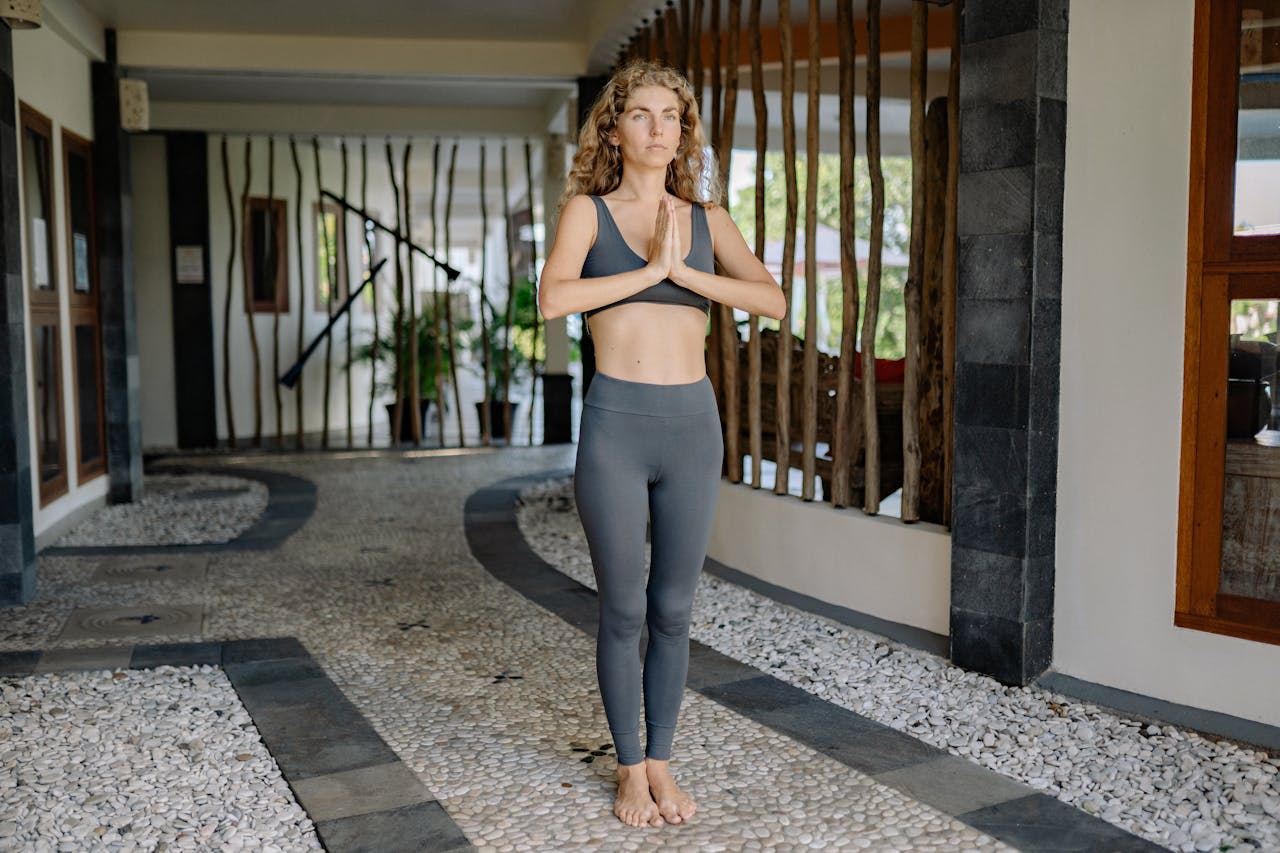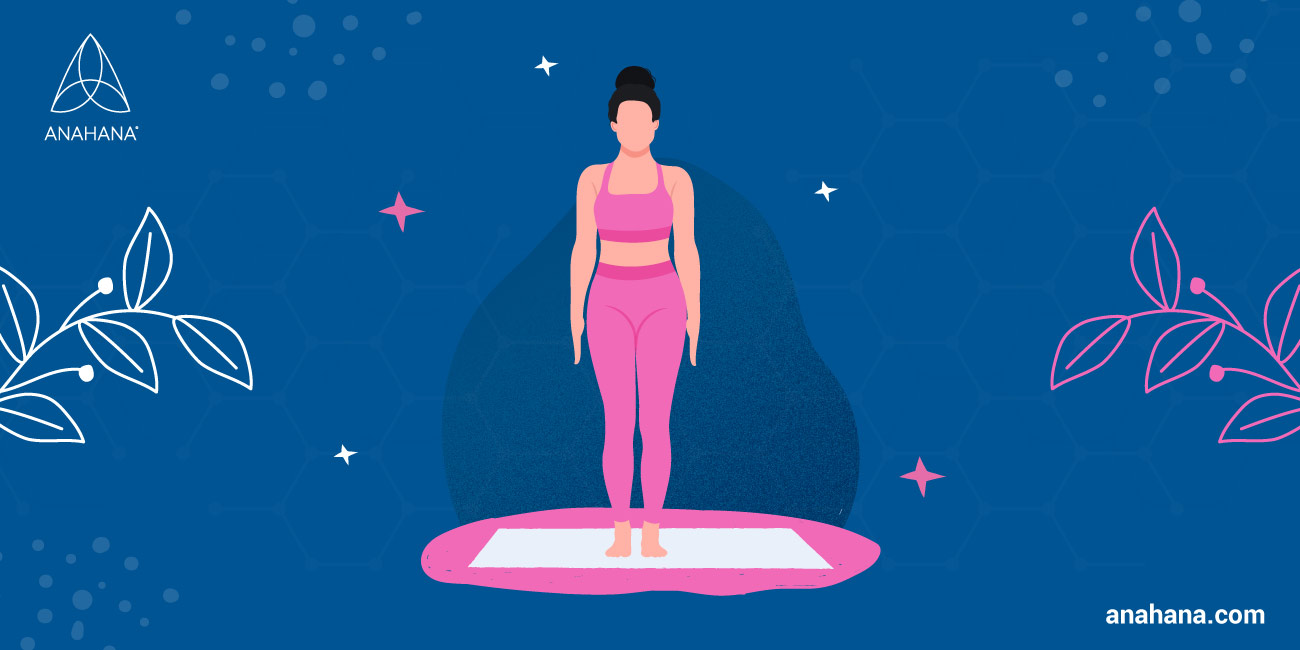
Table of Contents
Tadasana, or mountain pose, is a standing yoga pose. It is the first position used in surya namaskar or sun salutations. It is also a starting position for your yoga practice.
When to Perform Tadasana
While Tadasana is part of general yoga practice, it is noteworthy as the starting pose and final pose in most, if not all, Surya Namaskar sequences. As well as being used to start and finish sun salutations, Tadasana is one of the foundational Ashtanga yoga poses suitable for working on basic body awareness and control for other standing poses. Together with control and body awareness, it improves overall posture.
Many practitioners suggest that Tadasana is one of the options for breathing exercises as it allows one to breathe deeply and use the full motion of the diaphragmatic muscle.
Benefits of Tadasana Mountain Pose
Balance of root and heart chakras
Since the root chakra is responsible for stability and the idea of the foundation, while the heart chakra is associated with connections to the others, Tadasana can help bring energy balance to both.
Improved concentration and balance
Due to the feet positioning in the pose, balance can be a challenge. Tadasana makes one focus on finding the balance and being entirely concentrated on maintaining it.
Psoas stretch
One of the crucial parts of Tadasana is the lengthening of the spine, and back muscles, including the lower back. This movement helps to flatten the lower back and stretch the psoas.
Body scanning
Tadasana is most commonly held for a prolonged period, allowing to spot of pressure points, imbalances, and tightness in the body. Using body scanning techniques, practitioners can fully observe and tune into the body and analyze areas like knees, joints, hips, spine, and more.
Better proprioception
At slightly more advanced levels of practice, the practitioner can adjust parts of their body to work towards a better balance between the sides of the body, better proprioception, and balanced connective tissue tension.
Better posture
With the prevalence of smartphone use, tech neck or text neck is a problem. Tadasana is a relatively simple pose where good posture is a must. With the head back and chest comfortably lifted, the head's weight is balanced on an erect cervical spine (the part of the spine that makes up the neck) and creates the perfect posture dynamic.
Calmer mind
Wandering minds can benefit from Tadasana since it requires finding a visual anchor to maintain balance. With the concentration levels being elevated, it helps to calm the mind and distract from tumbling thought patterns.
How to Perform Tadasana
 Beginning to stand with feet together and knees straight, long arms by the sides, and palms facing inwards. Big toes can be touching, and heels slightly separated. If the balance is difficult, stand with your feet hip distance apart. The most important is to position the feet evenly.
Beginning to stand with feet together and knees straight, long arms by the sides, and palms facing inwards. Big toes can be touching, and heels slightly separated. If the balance is difficult, stand with your feet hip distance apart. The most important is to position the feet evenly.
Alternatively, putting hands together in a prayer position on a chest level is acceptable. With the hands in a prayer position (Anjali mudra), this standing pose is also known as Pranamasana. The Pranamanasana emphasizes the idea of reverence, and the pose, with hands in prayer, can positively affect the heart's chakra energy.
Adjusting your Feet and Positioning Your Center of Gravity
A typical instruction for the feet practicing mountain pose is to press into all four corners evenly. Another approach is to shift slightly left and right, finding the position where both feet press down with even pressure. From there, you can shift slightly forwards and backward. In this case, notice the change in pressure between your heels and forefeet. Experimenting with weight shifting allows one to find the most comfortable position with less foot tension.
Stabilizing Weak Ankles
Those with weak ankles can benefit from strengthening them by using their toes and pressing them down into the floor. Another option is to spread the toes and elongate them. Both of these options use muscles that cross the ankle joint, thus helping to stabilize and strengthen the ankles.
Engaging the knees
A common instruction yoga instructors give for the knees in mountain poses is to avoid locking them. There is an alternative approach to keeping the knees safe. With practice, it will become easier to add connective tissue tension to the thigh muscles.
This will cause the leg muscles, hips, and knees to activate and will allow them to stand with straight knees since the muscles surrounding them are fully activated. Other poses for engaging the knees are Urdhva Hastasana and Uttanasana.
Pelvic tilt and leg rotation in standing poses
In mountain poses and other yoga poses, the hips can be affected by leg rotation and the amount of forward-backward pelvis tilt. Generally, rotating the legs can affect pelvic tilt, and pelvic tilt can affect leg rotation. In either case, this can affect the connective tissue and muscle tension across hip joints.
While standing upright in a mountain pose, it might be beneficial to adjust the front-back tilt of the pelvis, either by lifting the pubic bone or lowering it to vary the amount of bend in the lower back.
Once the amount of pelvic tilt feels comfortable on the lower back, rotate the thighs in or out. Do so while keeping the feet still. In this case, this leg rotation will affect the amount of lift in the arches. Alternatively, pivot the feet, turning them with the thighs to maintain a comfortable degree of arch lift in the inner feet arches.
Note that the legs and pelvis are the base of this pose. The mountain pose becomes stronger and more stable by engaging the hips, knees, and feet.
Adjusting the spine
Rather than worrying about having a neutral spine position, a more straightforward solution is to think of spine elongation. The simple act of lengthening the spine activates muscle and adds connective tissue tension, all of which can be sensed. After that, it is possible to make adjustments across the entire spine, including the sacrum, to feel long. Once mastered, use this basic action in most other yoga poses.
Here is how to elongate the spine:
- Start by slightly tilting the pelvis forwards or backward. Find a position in which the lower back feels comfortably long. Generally, it helps to tilt the pelvis back so that the tailbone drops slightly.
- Adjust the amount of the tilt back so that the lower back feels comfortably long.
- Finally, extend the feeling of length to the back of the sacrum.
- From there, gently lift (and expand) all four sides of the ribcage. The intent here is not to lift as high as possible but relatively high enough to get a comfortable (and noticeable) feeling of connective tissue tension on all sides of the ribcage.
- Next, draw the ears back and up so that the head moves back and up relative to the ribcage. Rather than pulling the head back and up as far as possible, find a position where the tension in the neck feels comfortable.
- Point the crown of the head straight up.
Focusing on pulling the crown of the head up may shift the awareness outside of the body. Pulling back and up on the ears or the ear holes makes it easier to keep the awareness within the body's confines.
Pulling the head back and up should activate the chest lift. This may be harder to notice if the ribs are lifted; therefore, there is one way to vary the above sequencing:
- Lengthen the lower back.
- Pull the ears back and up.
- From there, check that the ribs are lifted and expanded on all four sides.
Adjusting the rib cage posture in standing yoga postures
The rib cage provides a foundation for shoulder blades and collar bones. These, in turn, are what support the arms. Your shoulders tend to sink forward when you drop your chest and move back when you lift it. In addition, you may find that falling your head forwards and down causes your chest to sink while pulling your head back and up causes your chest to lift.
So, if you pull your head back and up, you can use that action to lift your chest. In addition, you can vary the amount you pull your head back to get an optimum chest lift. If you pull your head back all the way, you’ll possibly notice excess tension in your waist and also at the back of your neck. And this is hard to maintain for an extended period.
So rather than going to the extreme, just short of it. Pull your head back and up, then adjust slightly forwards or rearwards so that your chest is still lifted but comfortably lifted. You’ll notice that the back of your neck and waist feel comfortably long. In addition, if your shoulder muscles are relaxed enough, your shoulders will be positioned so that your arms naturally hang by your sides.
Experiment with the amount of chest lift you use. With your chest lifted, you can exert a slight outwards and forwards pull on the bottom tips of your shoulder blades. At the same time, you can pull slightly backward on the peak of your shoulders (the bone at the top of each shoulder).
Activating and Adjusting the Arms in the Mountain Pose
 Once the chest and shoulders are comfortably adjusted, focus on elbow positioning by gentle straightening by softly locking the elbow joints. An option here is to add connective tissue tension to the upper arms, so they feel long. This should then make the elbows and shoulder muscles active.
Once the chest and shoulders are comfortably adjusted, focus on elbow positioning by gentle straightening by softly locking the elbow joints. An option here is to add connective tissue tension to the upper arms, so they feel long. This should then make the elbows and shoulder muscles active.
Slowly point the elbows back, noticing the sensation in the shoulders and at the front of the elbows. Gently spread and lengthen the fingers and note the sensations in each wrist and palm. Adjust hand position so that each wrist and hand feel comfortable.
References
(PDF) Benefits of Tadasana, Zhan Zhuang and Other Standing Meditation Techniques
Disclaimer
The contents of this article are provided for informational purposes only and are not intended to substitute for professional medical advice, diagnosis, or treatment. It is always recommended to consult with a qualified healthcare provider before making any health-related changes or if you have any questions or concerns about your health. Anahana is not liable for any errors, omissions, or consequences that may occur from using the information provided.

By: Anahana
The Anahana team of researchers, writers, topic experts, and computer scientists come together worldwide to create educational and practical wellbeing articles, courses, and technology. Experienced professionals in mental and physical health, meditation, yoga, pilates, and many other fields collaborate to make complex topics easy to understand. Anahana is also home to specialists in crystals, tarot, angel numbers, astrology, life path numbers, zodiac signs, and horoscopes. By combining evidence-based wellness with spiritual and energetic practices, the team offers clear, trustworthy guidance for both mind-body health and modern spirituality.